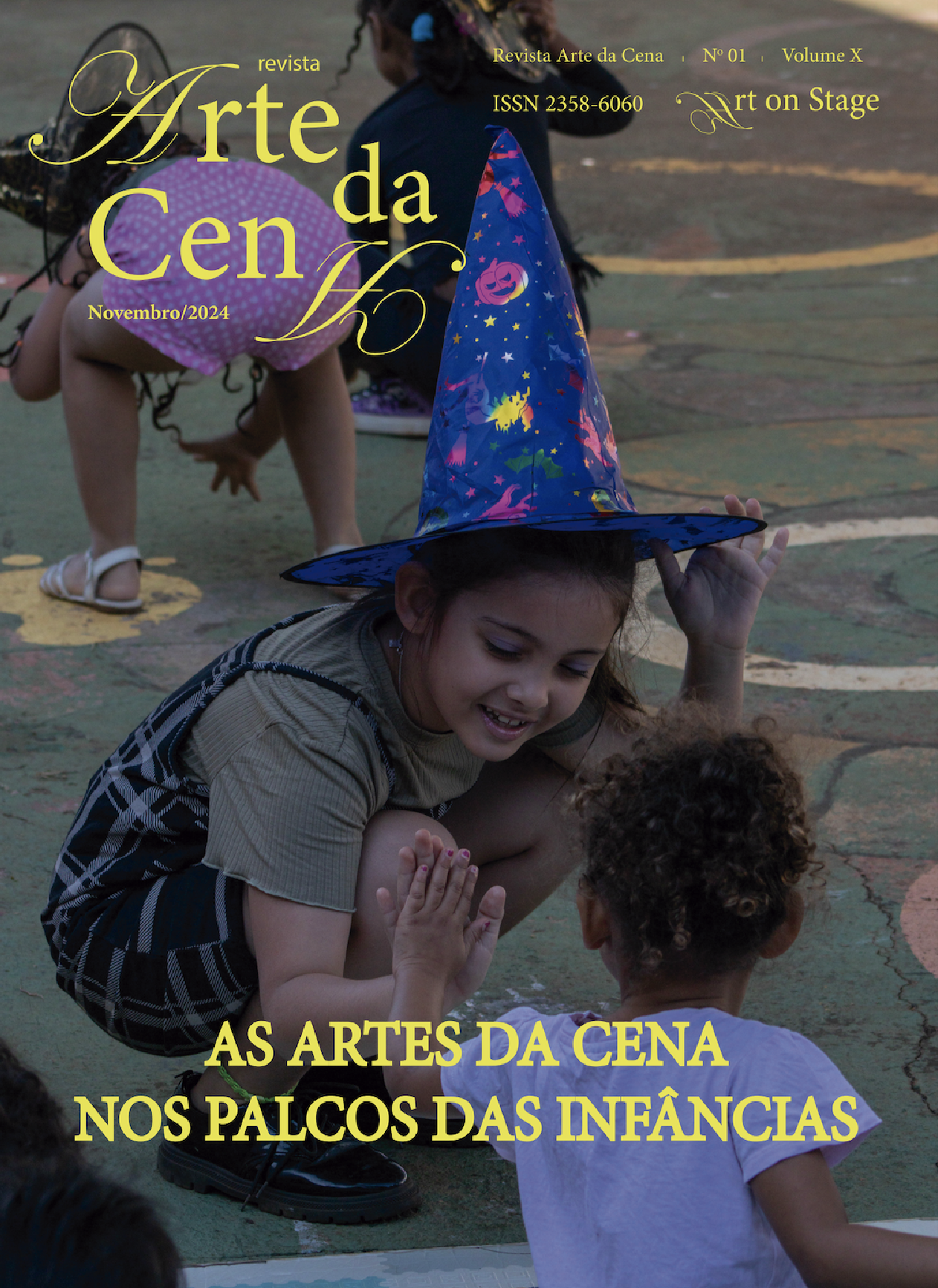From the dance that is thinking to the dance that is danced
DOI:
https://doi.org/10.5216/ac.v10i1.79402Abstract
The present work aims to present the paths of the master's research entitled: From the dance that is thought to the dance that is danced, carried out in the Art component in municipal public education in Rio Verde, Goiás. The general objective was to investigate ways of approaching the students enrolled in Elementary School II (6th to 9th Year) at Escola Municipal Rural de Ensino Fundamental Vale do Rio Doce with dance from an aesthetic-sensitive dimension and from a critical-emancipatory perspective. Methodologically, the study is characterized as qualitative research of an artistic nature associated with dance at school. The qualitative research was configured as a participatory research, involving 153 students enrolled in Elementary School II. Through a diagnostic analysis, the profiles of the target students of this study and the types of experiences they had with dance were identified, and a map of their experiences and expectations on the subject was created. Based on this mapping, dance actions were planned and developed that led to a broadening of the perspective and perception of reality and the world. Aiming to analyze the children's displacement in relation to dance, statements were collected that presented the particularities of the experiences lived during the development of this pedagogical work. The audiovisual records of the process and the oral and written testimonies were gathered into an artistic-pedagogical product in the format of a documentary, which was entitled “Dance you make me feel very confused, but I love you”.
Downloads
References
ALLEMAND, Débora Souto; BONFIM, Larissa. Diálogos entre Dança na Escola e dança no
TikTok: Propostas no ensino remoto. Urdimento - Revista de Estudos em Artes Cênicas,
Florianópolis, v. 2, n. 41, p. 1-30, 2021. DOI: 10.5965/141457310241 2021e0112. Disponível
em: <https://www.revistas.udesc.br/index.php/urdimento/arti cle/view/20480>. Acesso em: 03 de jan. de 2023.
CANDA, Cilene Nascimento; ALMEIDA, Verônica Domingues. Arte e saberes sensíveis na
formação e prática da docência. Revista do Programa de Pós- Graduação em Educação da
UFP, Teresina, Ano 23, n. 39, p. 71 – 90, mai./ago. 2018. Disponível em:
<file:///C:/Users/prof-/Downloads/7965-29133-1-PB.pdf>. Acesso em: 09 de jan. de 2023.
DUARTE JÚNIOR, João-Francisco. Por que arte-educação? 22. ed. (Coleção Ágere).
Campinas, SP: Papirus, 2012.
FERRAZ, Maria Heloísa C. de Toledo; FUSARI, Maria F. de Rezende e. Metodologia do
ensino de arte: fundamentos e proposições. 3. ed. rev. e ampl. São Paulo: Cortez, 2018.
FIAMONCINI, Luciana. Dança na educação: a busca de elementos na arte e na
estética. Pensar a Prática, Goiânia, v. 6, p. 59–72, 2006. Disponível em:
<https://revistas.ufg.br/fef/article/view/16055/9839>. Acesso em: 03 de jan. de 2023.
FIGUEIREDO, Valeska. A construção de significação na dança. Revista Poiésis, São Paulo,
v. 11, n. 15, p. 147-159, jul. de 2010. Disponível em:
<https://periodicos.uff.br/poiesis/article/view/26957/15662>. Acesso em: 03 de jan. de 2023.
FREIRE, Ana Maria de Araújo (Org.). Paulo Freire: À sombra desta mangueira. 12. ed. Rio
de Janeiro / São Paulo: Paz e Terra, 2019.
MARQUES, Isabel A. Ensino de dança hoje: textos e contextos. 6. ed. São Paulo: Cortez,
PONTES, Gilvânia Maurício Dias de. Reflexões sobre a experiência estética na educação.
Revista GEARTE, Porto Alegre, v. 2, p. 203 – 212, ago. 2015. Disponível em:
<https://seer.ufrgs.br/index.php/gearte/article/view/56448/34865>. Acesso em: 03 de jan. de
PORPINO, Karenine de Oliveira. Dança é Educação: Interfaces entre corporeidade e
estética. Natal, RN: EDUFRN, 2018.
SAVIANI, Dermeval. Trabalho e educação: fundamentos ontológicos e históricos. Rev.
Bras. Educ., Rio de Janeiro, v. 12, n. 34, p. 152-165, abr. 2007. Disponível em
<http://educa.fcc.org.br/scielo.php?script=sci_arttext&pid=S1413-247820070001000
&lng=pt&nrm=iso>. Acesso em: 12 de jan. de 2023.
SILVA, Alex Sander da; HONORATO, Aurélia Regina de Souza. Notas sobre experiência
estética na formação em artes como espaço possível. Poiésis, Tubarão/SC, v. 15, n. 27, p.
– 178, jan. / jun. de 2021. Disponível em:
<https://portaldeperiodicos.animaeducacao.com.br/index.php/Poiesis/article/view/8121>.
Acesso em: 03 de jan. de 2023.
STRAZZACAPPA, Márcia. Um, dois, três e já! A importância das artes cênicas na formação
humana. In: CRUZ, G.; FERNANDES, C.; FONTOURA, S. (orgs.) Didática(s) entre
diálogos, insurgências e políticas. Editora De Petrus. E-Book Kindle, 2020.
VIEIRA, Marcílio de Souza. Tessituras da dança: o seu fazer artístico, o seu viver, o seu
ensinar e aprender. Revista da FUNDARTE, [S. l.], v. 35, n. 35, p. 143–170, 2018.
Disponível em: <https://seer.fundarte.rs.gov.br/index.php/RevistadaFundarte/article
/view/494>. Acesso em: 12 fev. 2023.
Downloads
Published
How to Cite
Issue
Section
License
Copyright (c) 2024 Jovair Batista de Jesus, Luciana Gomes Ribeiro

This work is licensed under a Creative Commons Attribution-NonCommercial 4.0 International License.
The Art on Stage Journal uses the Creative Commons - Attribution-Non-Commercial 4.0 International license as a basis for transferring rights, for open access journals (Open Archives Initiative - OAI).
Authors who publish in this journal agree with the following terms:
1) Authors retain the copyright and grant the Art on Stage Journal the right to first publication, with the work simultaneously licensed under the Creative Commons Attribution Non Commercial License.
2) Authors are authorized to assume additional contracts separately, for non-exclusive distribution of the version of the work published in this Journal (eg, publishing in institutional repository or as a book chapter), with acknowledgment of authorship and initial publication in this journal.
3) Authors are allowed and encouraged to publish and distribute their work online (eg in institutional repositories or on their personal page) at any point before or during the editorial process, provided that the reference to the place of publication is cited, that is, the electronic address / reference of Art on Stage Journal.
4) The authors of the works published in the Art on Stage are expressly responsible for their content.
5) Authors will not be paid for publication of works in the Art on Stage Journal.



